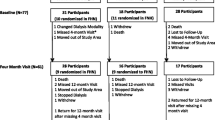Abstract
Twenty chronically dialyzed adults were administered a repeatable battery of 14 cognitive and sensory-motor tests on 3 consecutive days: immediately prior to their midweek dialysis, approximately 20 hr after their midweek dialysis, and again immediately prior to their end-of-the week dialysis. Serum electrolyte and methylamine analyses were performed at each test session. When compared to established norms, these patients scored within the normal range in a wide variety of areas. Limited impairments, probably due to peripheral neuropathy, were in evidence on the Grooved Pegboard, Finger Tapping (females), and Grip Strength (females) measures. Impairments suggestive of cerebral dysfunction were also noted on the Benton Visual Retention Test and on the Trail Making Test, Parts A and B, with particularly severe impairment noted on Part B. Despite significant daily changes in serum levels of toxic substances retained in uremia, there was little or no evidence to suggest that well-dialyzed patients undergo daily fluctuations in their cognitive and sensory-motor functioning.
Similar content being viewed by others
References
Abrams, H. S. (1969). The psychiatrist, the treatment of chronic renal failure, and the prolongation of life.II. Am. J. Psychiat. 126: 157–167.
Adams, K. M., Rennick, P. M., Schoof, K. G., and Keegan, J. F., (1975). Neuropsychological measurement of drug effects: Polydrug research.J. Psychedel. Drugs 2; 151–160.
Adams, K. M., Sawyer, J. D., and Kvale, P. A. (1980). Cerebral oxygenation and neuropsychological adaptation.J. Clin. Neuropsychol. 2: 189–208.
Ammons, R. G., and Ammons, C. H. (1962).The Quick-Test (QT): Provisional Manual, Psychological Test Specialists, Missoula, Mont.
Benton, A. L. (1963). TheRevised Visual Retention Test, The Psychological Corporation, New York.
Blatt, B., and Tsushima, W. T. (1966). A psychological survey of uremic patients being considered for the chronic hemodialysis program: Intellectual and emotional patterns in uremic patients.Nephron 3: 206–208.
Dunn, S. R., Simenhoff, M. L., and Wesson, L. G. (1976). Gas chromatograph determination of free mono-, di-, and trimethylamines in biological fluids.Anal. Chem. 48: 41–43.
Fishman, R., and Raskin, N. (1967). Experimental uremic encephalopathy.Arch. Neurol. 17: 10–21.
Friedman, E. (1978).The uremic syndrome. In Friedman, E. (ed.),Strategies in Renal Failure, Wiley, New York.
Ginn, H. E. (1973). Neurobehavioral and clinical responses to hemodialysis.Proceedings of the Sixth Annual Contractors Conference, DHEW Pub. (NIH) 74-248, Bethesda, Md.
Ginn, H. E. (1975). Neurobehavioral dysfunction in uremia.Kidney Int. Suppl. 2: 217–221.
Ginn, H. E., Teschan, P. E., Walker, P. J., Bourn, J. R., Fristoe, M., Ward, J. W., McLain, L. W., Johnston, H. B., and Hamel, B. (1975). Neurotoxicity in uremia.Kidney Int. Suppl. 3: 357–360.
Gorham, D. R. (1956). The Proverbs Test for clinical and experimental use.Psychol. Rep. 2: 1–12.
Greenberg, R. P., Davis, D., and Massey, R. (1973). The psychological evaluation of patients for a kidney transplant and hemodialysis program.Am. J. Psychiat. 130: 274–277.
Hagberg, B. (1974). A prospective study of patients in chronic hemodialysis. III.J. Psychosom. Res. 18: 151–160.
McDaniel, J. W. (1971). Metabolic and CNS correlates of cognitive dysfunction with renal failure.Psychophysiology 704–713.
Murawski, B. J. (1970). A measure of sustained attention in human uremics. In Bluemle, L. W., Colletti, R. B., and Krueger, K. K. (eds.),Workshop on Behavioral Bioassays in Uremia, National Institutes of Health, Bethesda, Md.
Murawski, B. J., Spector, E. L., and Follette, W. (1973). Elucidation of the toxic nature of uremia.Proceedings of the Sixth Anual Contractors Conference, DHEW Pub. (N. I. M.) 74-248, Bethesda, Md.
National Institutes of Health (1978).Manual for The Cooperative Dialysis Study, NIHNIAMDD, Contract NIH-NIAMDD NOI AM 6-2207, Washington, D.C.
Raskin, N. H., and Fishman, R. A. (1976). Neurological aspects of renal failure. In Brenner, B. M., and Rector, F. C. (eds.),The Kidney, Vol. II, Saunders, Philadelphia.
Reitan, R. M. (1969).Manual for Administration of Neuropsychological Test Batteries for Adults and Children, University of Washington Neuropsychology Laboratory, Seattle.
Reitan, R. M., and Davidson, L. (eds.) (1974).Clinical Neuropsychology: Current Status and Applications, Halstead, New York.
Rennick, P. M. (1974).Procedures for Repeatable-Cognitive-Perceptual-Motor Testing and General Neuropsychological Assessment, Lafayette Clinic, Detroit.
Sand, P., Livingston, G., and Wright, R. G. (1966). Psychological assessment of candidates for a hemodialysis program.Ann. Intern. Med. 64: 602–610.
Sharp, J., and Murphy, C. (1964). Conditioned avoidance behavior in primates during various experimental uremic states.Nephron 1: 172–179.
Simenhoff, M. L., Ginn, H. E., and Teschan, P. E. (1977). Toxicity of aliphatic amines in uremia.Trans. Am. Soc. Art. Organs 23: 560–564.
Spehr, W., Satorius, H., Berglund, K., Hjorth, B., Kablitz, C., Plog, U., Wiedeman, P. H., and Zapf, K. (1977). EEG and hemodialysis. A structural survey of EEG spectral analysis. Hijorth's EEG descriptions blood variables and psychological data.Electroenceph. Clin. Neurophysio. 43: 787–797.
Teschan, P. E., Ginn, H. E., Walker, P. J., Bourne, J. E., Fristoe, M., and Ward, J. W. (1974). Quantified functions of the nervous system in uremic patients on maintenance hemodialysis.Trans. Am. Soc. Art. Intern. Organs 20A: 338–392.
Thurstone, L. L. (1938).Primary Mental Abilities, University of Chicago Press, Chicago.
Trieschmann, R. B., and Sand, B. (1971). WAIS and MMPI correlates of increasing renal failure in adult medical patients.Psychol. Rep. 20: 1251–1262.
Wechsler, D. (1955).Manual for the Wechsler Adult Intelligence Scale, Psychological Corporation, New York.
Author information
Authors and Affiliations
Additional information
This study was done in partial fulfillment of the requirements for the degree of Doctor of Philosophy at the University of Windsor (D. Ratner). The research was supported in part by a grant from the Project and Human Rights Committe, Henry Ford Hospital. Appreciation is expressed to Dr. Michael L. Simenhoff, Jefferson Medical College, Philadelphia, for his consultation and analysis of serum amine products.
Rights and permissions
About this article
Cite this article
Ratner, D.P., Adams, K.M., Levin, N.W. et al. Effects of hemodialysis on the cognitive and sensory-motor functioning of the adult chronic hemodialysis patient. J Behav Med 6, 291–311 (1983). https://doi.org/10.1007/BF01315115
Accepted:
Issue Date:
DOI: https://doi.org/10.1007/BF01315115




